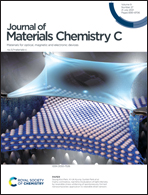Structural evolution of imine-linked covalent organic frameworks and their NH3 sensing performance†
Abstract
A series of imine-linked covalent organic frameworks (COF) are constructed under Sc(OTf)3 catalysis in a 1,4-dioxane/mesitylene mixture. The amount of Sc(OTf)3 catalyst strongly affects the structure of the as-synthesized COFs. When 0.005 equivalent Sc(OTf)3 is used, a crystalline COF with uniform micropores and high surface area is obtained. The as-synthesized COF evolves to a disordered structure with increase in the catalyst amount. Several imine-linked COFs show NH3 sensing ability at room temperature, and the NH3 sensing performance is strongly dependent on their electric conductivity. The imine-linked COF with a disordered structure has better electric conductivity than the crystalline imine-linked COF. The NH3 sensing ability of the imine-linked COF with a disordered structure is far better than that of the imine-linked COF with a crystalline structure. The excellent NH3 sensing ability, including a short response time, large response value and high sensing selectivity, as well as lower sensor baseline resistance were observed on the imine-linked COF with a disordered structure. The imine linkage was recognized as the active site for NH3 adsorption on the imine-linked COF. Both density functional theory (DFT) calculations and an in situ UV-Vis spectra experiment confirm a hydrogen bond formation between NH3 and imine linkage during the NH3 sensing process.



 Please wait while we load your content...
Please wait while we load your content...